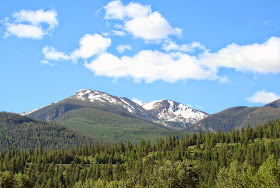After a quick stop at the Lolo Pass Visitor Center for directions, we found our way, on a dirt road, to Packer Meadows, a gorgeous field bursting with the lovely camas flowers as well as many other kinds of wildflowers. We gazed at a sea of blue in every direction!
Learning that the Nez Perce Indians depended on the camas flower, I looked up the use of the plant. It was sought out by many native peoples in the western U.S. and Canada. The bulb looks and tastes somewhat like a baked sweet potato, but sweeter. When dried, the bulbs can be pounded into a flour. Camas bulbs contributed to the survival of members of the Lewis and Clark Expedition of 1805 and 1806. It would fun to have a taste, but I realize digging wildflowers is not allowed in an historical place!
Another view of these gorgeous flowers.
An additional treat for us, as we traveled slowly along a 7 mile, very primitive road to the south of the Pass, was seeing what seemed like millions of spectacular bear grass blooms. They were covering the hillsides along the way. We had an amazing day, filled with not only these two delightful species, the camas and the bear grass, but also many other lovely wildflowers amidst high country forests. We live in a magnificent country!





No comments:
Post a Comment